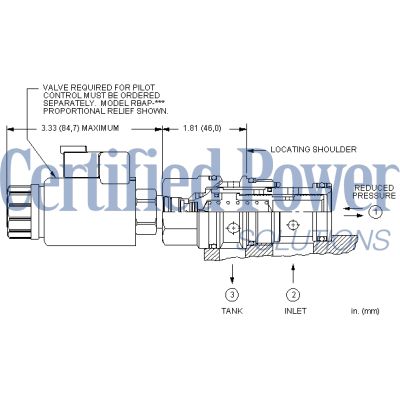SUN HYDRAULICS
RELIEF VALVE
PPHF8WN
$269.99 USD
- SUN HYDRAULICS
- Material:PPHF8WN
- Model:PPHF-8WN
- Summary:Cartridge
Quantity in stock: 33
***Disclaimer: The following summary contains information gathered from various sources such as product descriptions, technical specifications and catalogs. While efforts have been made to provide accurate details, inaccuracies may occur. It is advised to verify all information by contacting Sun Hydraulics directly.***
The Sun Hydraulics PPHF8WN (PPHF8WN) is a versatile 3-way, normally open modulating valve element designed for demanding hydraulic applications. This valve features an integral pilot control cavity compatible with any T8A pressure control cartridge, allowing it to reduce high primary pressure at inlet port 2 to a constant reduced pressure at port 1. It also provides a full flow relief function from port 1 to the tank port 3. The main stage orifice is drilled directly into the piston, enhancing durability in physically demanding environments. The valve's performance is characterized by low deadband transition between reducing and relieving modes and exceptionally stable pressure-flow characteristics with low hysteresis. The PPHF8WN model allows for maximum operating pressures up to 5000 psi (350 bar) and incorporates Sun's floating style construction to minimize internal binding due to installation torque or machining variations. With its pilot-operated design, this valve exhibits a flat pressure-flow curve and can be configured with various pilot control cartridges that include electro-proportional, solenoid, air pilot, and hydraulic pilot operations. These cartridges are sold separately. For optimal performance, the maximum pressure at port 3 should not exceed 3000 psi (210 bar), and reverse flow from reduced pressure port 1 to inlet port 2 may require an additional check valve in the circuit if free flow is necessary. The PPHF8WN model also ensures interchangeability among all three-port pressure reducing and reducing-relieving cartridges of the same frame size. Installation requires specific torque values for both the main stage valve and the T8A pilot control valve, ensuring proper integration into hydraulic systems that demand precise pressure regulation capabilities.
The Sun Hydraulics PPHF8WN (PPHF8WN) is a versatile 3-way, normally open modulating valve element designed for demanding hydraulic applications. This valve features an integral pilot control cavity compatible with any T8A pressure control cartridge, allowing it to reduce high primary pressure at inlet port 2 to a constant reduced pressure at port 1. It also provides a full flow relief function from port 1 to the tank port 3. The main stage orifice is drilled directly into the piston, enhancing durability in physically demanding environments. The valve's performance is characterized by low deadband transition between reducing and relieving modes and exceptionally stable pressure-flow characteristics with low hysteresis. The PPHF8WN model allows for maximum operating pressures up to 5000 psi (350 bar) and incorporates Sun's floating style construction to minimize internal binding due to installation torque or machining variations. With its pilot-operated design, this valve exhibits a flat pressure-flow curve and can be configured with various pilot control cartridges that include electro-proportional, solenoid, air pilot, and hydraulic pilot operations. These cartridges are sold separately. For optimal performance, the maximum pressure at port 3 should not exceed 3000 psi (210 bar), and reverse flow from reduced pressure port 1 to inlet port 2 may require an additional check valve in the circuit if free flow is necessary. The PPHF8WN model also ensures interchangeability among all three-port pressure reducing and reducing-relieving cartridges of the same frame size. Installation requires specific torque values for both the main stage valve and the T8A pilot control valve, ensuring proper integration into hydraulic systems that demand precise pressure regulation capabilities.
This valve is a 3-way, normally open modulating element that incorporates an integral pilot control cavity. The pilot control cavity will accept any T-8A pressure control cartridge. The valve reduces a high primary pressure at the inlet (port 2) to a constant reduced pressure at port 1, with a full flow relief function from port 1 to tank (port 3). The pilot cartridge's setting determines the difference in pressure between reduced pressure (port 1) and the tank (port 3).
- These valves have the main stage orifice drilled into the piston rather than a staked-in orifice. This allows the valve to survive physically demanding applications.
- Pressure at port 3 is directly additive to the valve setting at a 1:1 ratio and should not exceed 3000 psi (210 bar).
- Maximum pressure at port 3 should be limited to 3000 psi (210 bar).
- Pilot operated valves exhibit very low dead-band transition between reducing and relieving modes.
- Pilot operated valves exhibit exceptionally flat pressure/flow characteristics, are very stable and have low hysteresis.
- Full reverse flow from reduced pressure (port 1) to inlet (port 2) may cause the main spool to close. If reverse free flow is required in the circuit, consider adding a separate check valve to the circuit.
- All three-port pressure reducing and reducing/relieving cartridges are physically interchangeable (i.e. same flow path, same cavity for a given frame size). When considering mounting configurations, it is sometimes recommended that a full capacity return line (port 3) be used with reducing/relieving cartridges.
- Maximum inlet pressure is determined by the bias spring. The D spring is tested with 2000 psi (140 bar) maximum differential pressure and the W spring is tested with 5000 psi (350 bar) maximum inlet pressure.
- NOTE: With the -8 control option, the main stage valve should first be installed to the correct torque value. The T-8A pilot control valve should then be installed into the main stage valve to its required torque value.
- The -8 control option allows the pilot control valve to be incorporated directly into the end of the relief cartridge via the T-8A cavity. These pilot control cartridges are sold separately and include electro-proportional, solenoid, air pilot, and hydraulic pilot operation. See Pilot Control Cartridges.
- Incorporates the Sun floating style construction to minimize the possibility of internal parts binding due to excessive installation torque and/or cavity/cartridge machining variations.
| Cavity | T-17A |
| Series | 3 |
| Capacity | 40 gpm160 L/min. |
| Maximum Operating Pressure | 5000 psi350 bar |
| Control Pilot Flow | 15 - 20 in³/min.0,25 - 0,33 L/min. |
| Pilot Control Cavity | T-8AT-8A |
| Pilot Control Valve Installation Torque | 20 - 25 lbf ft27 - 33 Nm |
| Pilot Control Valve Hex Size | 7/8 in.22,2 mm |
| Valve Hex Size | 1 1/4 in.31,8 mm |
| Valve Installation Torque | 150 - 160 lbf ft203 - 217 Nm |
| Model Weight | 1.30 lb0,60 kg |
| Seal kit - Cartridge | Viton: 990-017-006 |
Show FAQ
Additional Resources
- Weatherized Solenoid Valves for Harsh Environments
- Configure Your Bluetooth Embedded Amplifier with AmpSet Blue™
- Series 4 PLUS Cartridges Offer Higher Flows with Lower Pressure Losses
- QuickDesign with SmartConnect Offers Drag-and-Drop Schematic Tool
- Electro-Proportional Basics Explained
- Sun Offers Zinc-Nickel Plating for Corrosion Resistance
- Sun Expands Corrosion-Resistant Solutions
- Sun Cartridges with EPDM Seals
- Solenoid Coils for Switching and Proportional Valves
- Reducing and Reducing/Relieving Valves
- Proportional Amplifiers and Ancillary Products
- Manufacturing Sun Cartridge Cavities
- Sun's Floating Style Screw-In Cartridge
- Fluid and Temperature Recommendations
- Sun Model Code Explanation; 999-901-334
- Performance Data
- Cartridges: Materials of Construction
- Units of Measure, Settings, and Conversions
- Electro-Proportional Terms and Definitions
- Cavity Information (S-171) and Tooling
Notes:
- Compound cartridge (pilot and main stage) assembly information is provided for reference only. Cartridges must be ordered separately and assembled at point of use.

